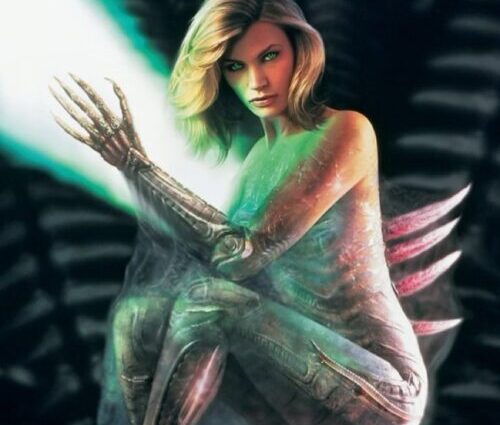Sure, the plot lacks originality but it’s a solid B movie—and H.R. Giger designed the alien lifeform.
Earlier this month, Hollywood mourned the passing of Michael Madsen, a gifted actor best known for his critically acclaimed roles in Reservoir Dogs, Kill Bill, and Donnie Brasco, among others. Few obituaries have mentioned one of his lesser-known roles: a black ops mercenary hired to help hunt down an escaped human/alien hybrid in 1995’s Species. The sci-fi thriller turns 30 this year and while it garnered decidedly mixed reviews upon release, the film holds up quite well as a not-quite-campy B monster movie that makes for a great guilty pleasure.
(Many spoilers below.)
Screenwriter Dennis Feldman (The Golden Child) was partially inspired by an Arthur C. Clarke article discussing how the odds were slim that an extraterrestrial craft would ever visit Earth, given the great distances that would need to be traversed (assuming that traveling faster than the speed of light would be highly unlikely). Feldman was intrigued by the prospect of making extraterrestrial contact via information: specifically, alien instructions on how to build an instrument that could talk to terrestrial humans.
That instrument wouldn’t be mechanical but organic, enabling an extraterrestrial visitor to adapt to Earth via combined DNA. Furthermore, rather than viewing projects like SETI or the Voyager missions—both of which sent transmissions containing information about Earth—as positive, Feldman considered them potentially dangerous, essentially inviting predators to target Earth’s inhabitants. His alien would be a kind of bioweapon. The result was Species, which began as a spec script that eventually attracted the interest of MGM and director Roger Donaldson (The Bounty, No Way Out).
The premise is that the US government receives a response to the transmissions set into space: one message gives instructions on a new fuel source; the other contains explicit instructions on how to create an alien DNA sample and splice it with that of a human. Dr. Xavier Fitch (Ben Kingsley) is the scientist in charge of conducting the latter experiment, and the result is Sil (played as a young girl by Michelle Williams), a female alien/human hybrid they believed would have “docile and controllable” traits.
In just three months, Sil develops into a 12-year-old girl. But she starts exhibiting odd behavior as she sleeps, indicative of violent tendencies. Fitch decides to terminate the experiment, which means killing Sil by filling her containment cell with cyanide gas. A betrayed Sil breaks out of her cell and escapes. Fitch (who is the worst) puts together a crack team to track her down and eliminate her: mercenary Preston Lennox (Madsen); a molecular biologist named Dr. Laura Baker (a pre-CSI Marg Helgenberger); anthropologist Dr. Stephen Arden (Alfred Molina), and an “empath” named Dan Smithson (Forest Whitaker).
An experiment run amok
Preston Lennox (Michael Madsen), Dan Smithson (Forest Whitaker), Dr. Xavier Fitch (Ben Kingsley), and Dr. Laura Baker (Marg Helgenberger) must hunt down an escaped alien/human hybrid
MGM
Sil won’t be easy to find. Not only does she evade detection and hop on a train to Los Angeles, she transforms into a cocoon stage en route, emerging as a fully grown female (Natasha Henstridge) upon arrival. She’s smart and resourceful, too—and very deadly when she feels her survival is threatened, which is often. The team must locate Sil before she manages to mate and produce equally rapid-developing offspring. At least they can follow all the bodies: a tramp on the train, a train conductor, a young woman in a nightclub, a rejected suitor, etc. Of course, she finally manages to mate—with an unsuspecting Arden, no less—and gives birth in the labyrinthine LA sewers, before she and her hybrid son meet their grisly demises.
One can only admire H.R. Giger’s striking alien design; he wanted to create a monster who was “an aesthetic warrior, also sensual and deadly,” and he very much delivered on that vision. He had also wanted several stages of development for Sil, but in the end, the filmmakers kept things simple, limiting themselves to the cocoon stage that shepherded young Sil through puberty and Sil’s final alien maternal form with translucent skin—described as being “like a glass body but with carbon inside.”
That said, Giger didn’t much care for the final film, which he thought was much too similar to the Alien franchise, which boasts his most famous creature design, the xenomorph. For instance, there is the same punching tongue (Giger had wanted to incorporate barbed hooks for Sil), and Sil giving birth seems eerily akin to Alien‘s famous “chestburster” scene. Giger did manage to convince the director to have the team ultimately take out Sil with a fatal shot to the head, rather than with flame-throwers, which he felt was too derivative of Alien 3 and Terminator 2: Judgement Day.
Giger had a point: Species is not particularly ground-breaking or original in terms of plot or the nature of the alien posing a threat to humankind. The dialogue is uninspired (occasionally downright trite) and the characters aren’t well developed, most notably Kingsley’s weak-willed amoral scientist and Whitaker’s reluctant empath—both exceptionally gifted actors who are largely wasted here. Poor Whitaker is reduced to looking broody and stating the obvious about whatever Sil might be “feeling.” There are gestures towards themes that are never fully explored and the outcome is predictable, right down to the final twist.
The mating game
Sil picks up a potential mate (Anthony Guidera) at ta local club
MGM
But there’s also plenty to like about Species. Madsen and Helgenberger give strong performances and have excellent on-screen chemistry; their sweetly awkward sex scene is the antithesis to Sil’s far more brutal approach—in fact, Sil learns more about the subtleties of seduction by eavesdropping on the pair. And the film is well-paced, with all the right beats and memorable moments for a successful sci-fi thriller.
Former model Henstridge acquits herself just fine in her debut role. Much was made in the press of Henstridge’s nude scenes, but while her beauty is used to great effect, it’s the character of Sil and her journey that compels our attention the most, along with our shifting emotions toward her. Young Sil is sympathetic, the result of an unethical science experiment. She didn’t ask to be born and has little control over what is happening to her. But she does want to live (hence her escape) and is genuinely scared when she begins to transform into her cocoon on the train.
Our sympathy is tested when adult Sil brutally kills a kindly train conductor, and then a romantic rival in a nightclub, both in a very gruesome manner. We might be able to rationalize the killing of the first rejected suitor, since he refuses to accept she’s changed her mind about mating with him and gets rough. But nice guy John (Whip Hubley)? The woman she takes as hostage to fake her own death? Both offered to help Sil and died for their trouble.
Granted, Sil’s distrust of humans is learned. She is being hunted by a team of professionals who intend to kill her, after all. When the woman hostage swears she won’t harm Sil if she lets her go, Sil responds, “Yes you would. You just don’t know it yet.” We gradually realize that Sil is not that little girl any longer—if she ever was—but a ruthless creature driven entirely by instinct, even if she doesn’t fully understand why she’s been sent to Earth in the first place. As Laura notes, adult Sil views humans as disposable “intergalactic weeds.” By the time we get to the showdown in the sewer, Sil isn’t even in human form anymore, so the audience has no qualms about her eventual violent demise.
Species performed well enough at the box office to spawn multiple sequels—each one worse than the last— an adapted novel, and a Dark Horse Comics series. None of them captured the unique combination of elements that lifted the original above its various shortcomings. It will never match Alien, but Species is nonetheless an entertaining ride.
Jennifer is a senior writer at Ars Technica with a particular focus on where science meets culture, covering everything from physics and related interdisciplinary topics to her favorite films and TV series. Jennifer lives in Baltimore with her spouse, physicist Sean M. Carroll, and their two cats, Ariel and Caliban.



